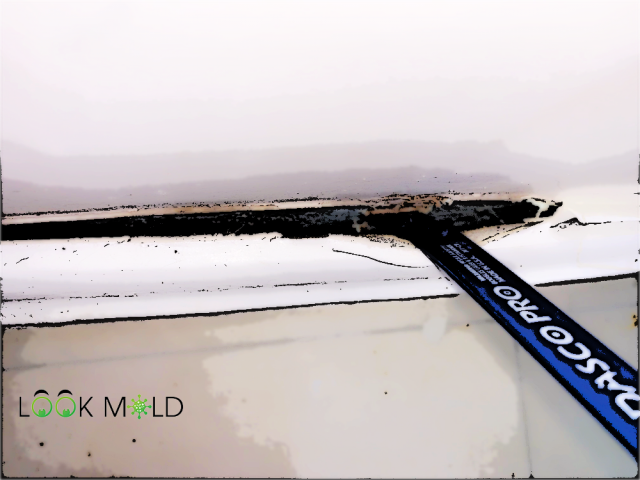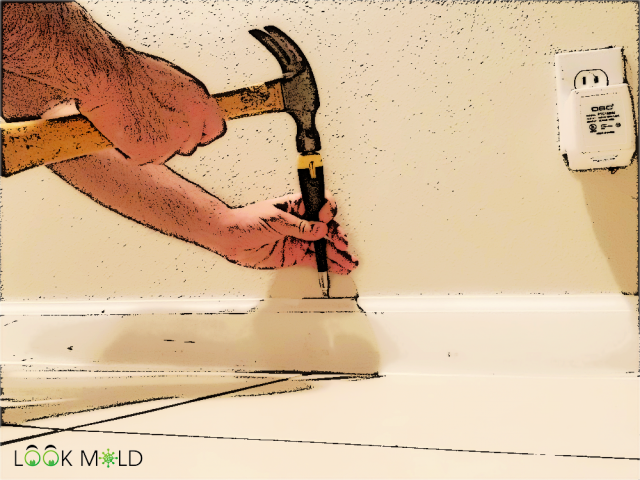Professional Mold Remediation Services
Don't Let Toxic Mold Put Your Family's Health at Risk
Stop mold damage before it spreads. Call now for a free, no-obligation estimate from a local remediation expert.
Free Estimate · Zero Obligation · Available 24/7
Mold Behind Baseboards
Discovering hidden mold in a home can be a challenge. One of the most tell-tale signs you have a problem is finding mold behind baseboards.
But just because you are finding fungal growth behind baseboards, does it always indicate that you have a severe problem?
No, not always.
In this article, you are going to learn:
- What Causes Mold Behind Baseboard
- Is Mold Behind Baseboards Dangerous
- Signs of Water Damage
- How To Look Behind Baseboards
- How To Correct The Problem
What Causes Mold To Grow Behind Baseboards

The root cause of mold behind baseboards is due to water intrusion. Water can accumulate due to roof leaks, window leaks, air conditioning leaks, as well as many other causes. Once water gets behind the baseboard, it will not dry for a long time allowing mold to colonize and grow both on the the wall behind the baseboard and backside of it.
The reason water will not dry quickly is because with the baseboard in place over the sheetrock or plaster walls, the area cannot air out, nor will it get sunlight.
It will stay saturated for months.
Not only will mold be on the back of the baseboard, but it can also be on the wall behind as well as inside the walls. In the case where the walls are plaster, it will typically just be on the back of the baseboard and maybe any structural wood inside the walls. The reason being, mold does not grow on plaster.
Mold Goes Unnoticed Behind Baseboards
Time plays a key role in the forming of mold colonies. Because mold will grow in the rear of the baseboard, it will often be unnoticed for a long time.
Leaks from the outside won’t always flood the house. In many instances, such as chronic window leaks, water can get in periodically, like during rainstorms. A catastrophic flood may be more devastating, but at least you can detect it in a timely matter and correct the issue as opposed to long-term leaks.
Is Mold Behind Baseboards Dangerous?
Mold behind baseboards does not always pose an immediate threat. The microbial growth is usually encapsulated beneath the baseboard, not always allowing spores to become airborne. When the materials are wet, it often weighs the mold spores down and does not allow it to aerosolize easily.
That is why if a mold air test is down by yourself or a mold inspector, mold behind baseboards will not always be picked up.
Does this mean that mold behind the baseboards is not dangerous?
Absolutely not!
Quite the contrary. Because the porous materials in the back of the baseboard remain wet for long periods, it allows slow-growing mold species such as Stachybotrys to thrive. Having black toxic mold can be worrisome, but it is often concealed and not airborne (until you remove the baseboard).
Signs Of Water Behind Baseboards
Detecting mold on the backside of baseboards is difficult, but there are a few warning signs that can help you.
The signs are there, but ultimately, it will be up to you to be conscious of them.
Baseboards Pulling Away

When baseboards made of building materials such as wood get wet, they expand. When baseboards expand, they start pulling away from the wall. So, it could be a clear indication of water intrusion if you see baseboards separating.
Now:
There are other reasons that baseboards can detach itself from the wallboard, such is incorrect installation.
It could also mean there is high humidity in the house, allowing the baseboards to hold moisture and start pulling away.
Water Stains

The staining can be in a multitude of colors, including: • Brown • Clear Blue • Gray Be careful not to confuse mold with scuff marks.
Paint Chipping

Paint chipping or deterioration on the baseboard is evidence of possible water penetration into the walls.
While it could also be marked from the baseboards being banged or chewed on by animals, it could also indicate water damage.
Black Tack strips

Tack strips are usually wood with little metal spikes that are used to lay down carpets along the edge of the room.
When the tack strips get wet, the wood gets rotted and starts to turn black. This is a direct signal of water intrusion. You may also find mold on the carpet or on the backside of it. If the carpet got wet, there is a good chance so did the baseboard.
How To Look Behind Baseboards
While the above are all great indicators of possible mold behind the baseboard, there is only one way to be certain.
Pull back the baseboards and take a peek!

To peel back the baseboard, you don’t need to be handy, but you need a couple of tools.
Depending on your baseboards, there is a possibility by pulling it back; you could damage them.
Get yourself:
• A crowbar (preferably mini one)
• Flathead screwdriver or chisel
• Hammer
•
Option 1

Put the crowbar on the top of the baseboard. If there is caulking on top of the baseboard, you may want to get a box cutter and cut a slit in the caulk.
Dig the crowbar into the baseboard with moderate pressure.
Shimmy it back to reveal behind the baseboard. You may be able to pull back the baseboard without removing it and see what’s going on in some cases.
Option 2

Use a hammer to hit the back of the tool digging into the baseboard.
Try not to hammer too hard as it can go right through the drywall.
You should be able to remove the baseboard or at least well enough to see in the back of it.
Keep in mind, even if you did not find growth, it doesn’t mean there isn’t inside the walls.
How To Correct The Problem
Just because you find mold, it doesn’t automatically mean you will need to have expensive mold remediation performed. plugin:youtube
The EPA recommends only having mold remediation performed in an area larger than 10 square feet.
You will need to use your judgment depending on what you find.
If the mold appears to be extraordinarily dense regardless of color, you should probably contact a licensed mold investigator or other professionals to investigate further.
The mold may appear to be centralized but could be further concealed within walls. Just think, if the cause is a roof leak, you may have mold crawling up the entire wall. It’s not worth it to attempt the work yourself as you can contaminate your entire home through your air conditioning ducts.
If the mold present appears powdery and easily comes off, there is a good chance; this is just a superficial mold and likely insignificant. If this instance, you can probably feel confident removing the mold by yourself as long as you are wearing the proper PPE.
Stopping The Water Source
Yes, removing the mold is important, but what good does it do if the cause is not corrected?
Figuring out the cause of the water damage is crucial.
Whether you need to water test windows, doors, call in a leak detection company, etc. The cause of the leak must be verified before putting on new drywall and baseboards.
Once you successfully identified the cause and removed or cleaned up the mold, you can put a brand new baseboard back and place that will hopefully never have to be removed!
Explore Related Topics:
Notice an update we should make?
We strive for accuracy. Contact us here if you see incorrect or outdated info on this page.

